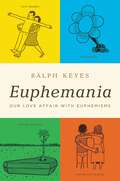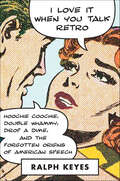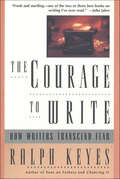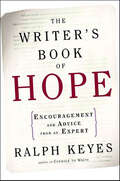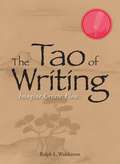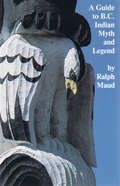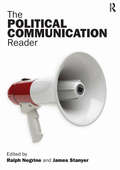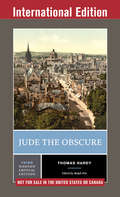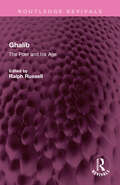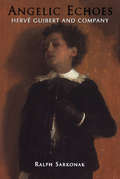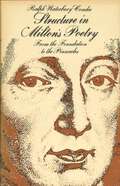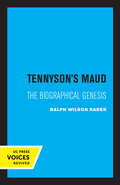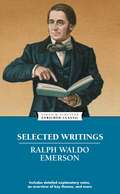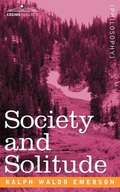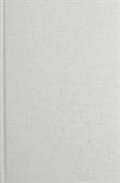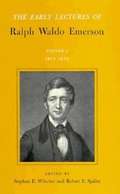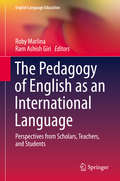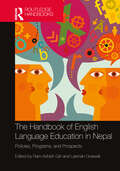- Table View
- List View
Euphemania: Our Love Affair with Euphemisms
by Ralph KeyesHow did die become kick the bucket, underwear become unmentionables, and having an affair become hiking the Appalachian trail? Originally used to avoid blasphemy, honor taboos, and make nice, euphemisms have become embedded in the fabric of our language. EUPHEMANIA traces the origins of euphemisms from a tool of the church to a form of gentility to today's instrument of commercial, political, and postmodern doublespeak. As much social commentary as a book for word lovers, EUPHEMANIA is a lively and thought-provoking look at the power of words and our power over them.
I Love It When You Talk Retro: Hoochie Coochie, Double Whammy, Drop a Dime, and the Forgotten Origins of American Speech
by Ralph KeyesAn entertaining and informative book about the fashion and fads of language Today's 18-year-olds may not know who Mrs. Robinson is, where the term "stuck in a groove" comes from, why 1984 was a year unlike any other, how big a bread box is, how to get to Peyton Place, or what the term Watergate refers to. I Love It When You Talk Retro discusses these verbal fossils that remain embedded in our national conversation long after the topic they refer to has galloped off into the sunset. That could be a person (Mrs. Robinson), product (Edsel), past bestseller (Catch-22), radio or TV show (Gangbusters), comic strip (Alphonse and Gaston), or advertisement (Where's the beef?) long forgotten. Such retroterms are words or phrases in current use whose origins lie in our past. Ralph Keyes takes us on an illuminating and engaging tour through the phenomenon that is Retrotalk—a journey, oftentimes along the timelines of American history and the faultlines of culture, that will add to the word-lover's store of trivia and obscure references. "The phrase "drinking the Kool-Aid" is a mystery to young people today, as is "45rpm." Even older folks don't know the origins of "raked over the coals" and "cut to the chase." Keyes (The QuoteVerifier) uses his skill as a sleuth of sources to track what he calls "retrotalk": "a slippery slope of puzzling allusions to past phenomena." He surveys the origins of "verbal fossils" from commercials (Kodak moment), jurisprudence (Twinkie defense), movies (pod people), cartoons (Caspar Milquetoast) and literature (brave new world). Some pop permutations percolated over decades: Radio's Take It or Leave It spawned a catch phrase so popular the program was retitled The $64 Question and later returned as TV's The $64,000 Question. Keyes's own book Is There Life After High School? became both a Broadway musical and a catch phrase. Some entries are self-evident or have speculative origins, but Keyes's nonacademic style and probing research make this both an entertaining read and a valuable reference work." --Publishers Weekly
The Courage to Write: How Writers Transcend Fear
by Ralph KeyesThe Courage to Write is an invaluable book and essential reading for anyone who wishes to learn how to write well.Katherine Anne Porter called courage "the first essential" for a writer. "I have to talk myself into bravery with every sentence," agreed Cynthia Ozick, "sometimes every syllable." E. B. White said he admired anyone who "has the guts to write anything at all."An author who has taught writing for more than thirty years,In The Courage to Write, Ralph Keyes, an author who has taught writing for more than thirty years, assures us that anxiety is felt by writers at every level, especially when they dare to do their best. He describes the sequence of "courage points" through which all writers must pass, from the challenge of identifying a worthwhile project to the mixture of pride and panic they feel when examining a newly published book or article. Keyes also offers specifics on how to root out dread of public "performance" and of the judgment of family and friends, make the best use of writers' workshops and conferences, and handle criticism of works in progress. Throughout, he includes the comments of many accomplished writers -- Pat Conroy, Amy Tan, Rita Dove, Isabel Allende, and others -- on how they transcended their own fears to produce great works.
The Writer's Book of Hope: Encouragement and Advice from an Expert
by Ralph KeyesIn 1889, the editor of the San Francisco Examiner, having accepted an article from Rudyard Kipling, informed the author that he should not bother to submit any more. "This isn't a kindergarten for amateur writers," the editor wrote. "I'm sorry, Mr. Kipling, but you just don't know how to use the English language." A century later, John Grisham was turned down by sixteen agents before he found representation-and it was only after Hollywood showed an interest in The Firm that publishers began to take him seriously. The anxiety of rejection is an inevitable part of any writer's development. In this book, Ralph Keyes turns his attention from the difficulty of putting pen to paper-the subject of his acclaimed The Courage to Write -to the frustration of getting the product to the public. Inspiration isn't nearly as important to the successful writer, he argues, as tenacity, and he offers concrete ways to manage the struggle to publish. Drawing on his long experience as a writer and teacher of writing, Keyes provides new insight into the mind-set of publishers, the value of an agent, and the importance of encouragement and hope to the act of authorial creation.
The Tao Of Writing: Imagine. Create. Flow.
by Ralph L WahlstromA Simon & Schuster eBook. Simon & Schuster has a great book for every reader.
The Tao Of Writing
by Ralph L. WahlstromThe creative process doesn't have to be torturous--with The Tao of Writing, it can be glorious! Invoking the principles of the Tao allows you to do your best work ever. By tapping into the true flow of your creativity, you can discover and develop your true talents and abilities. Author Ralph Wahlstrom uses the connection between teaching, writing, and the tenets of the Tao to help you learn to write from a new perspective, enhancing your work and your creative journey. With The Tao of Writing as your guide, you can overcome "writer's rigor mortis," and become a better, happier, more productive writer.
The Tao of Writing: Imagine, Create, Flow
by Ralph L. Wahlstrom.The creative process doesn't have to be torturous-with The Tao of Writing, it can be glorious! Invoking the principles of the Tao allows writers do their best work ever. By tapping into the true flow of their creativity, writers can discover and develop their true talents and abilities. Author Ralph L. Wahlstrom uses the connection between teaching, writing, and the tenets of the Tao to help writers hone their craft from a new perspective, enhancing their work and their creative journey. Organized into three parts, this engaging book is as practical as it is inspiring: The Philosophy-Why the Tao in Writing?: A brief introduction to Taoist thought, drawing from the tao te ching, Chuang tze, the Tao of Pooh, and well-known writers The Twelve Principles of Tao in Writing: Exploring the twelve principles of the Tao in relation to writing Applying the Tao to Writing: More than 100 writing exercises that help set writers in motion and build their momentum to create original, well-realized works With The Tao of Writing as their guide, readers can overcome "writer's rigor mortis," and become better, happier, more productive writers.
A Guide to B.C. Indian Myth and Legend
by Ralph MaudBoas, Teit, Hill-Tout, Barbeau, Swanton, Jenness, the luminaries of field research in British Columbia, are discussed here in A Guide to B.C. Indian Myth and Legend, and their work in Indian folklore evaluated. Other scholars, amateurs and Native informants of the past and present are given ample consideration, making this book a comprehensive survey of myth collecting in B.C. The aim is to reveal the true extent of this neglected body of world literature, and to begin to sort out the more valuable texts from those damaged in transmission. A Guide to B.C. Indian Myth and Legend is a valuable reference tool for beginning or advanced students of anthropology, and an absorbing look at the research process itself.
A Guide to B.C. Indian Myth and Legend
by Ralph MaudBoas, Teit, Hill-Tout, Barbeau, Swanton, Jenness, the luminaries of field research in British Columbia, are discussed herein, and their work in Indian folklore evaluated. Other scholars, amateurs, and Native informants of the past and present are given consideration, making this book a comprehensive survey of myth collecting in B.C. a valuable reference tool for beginning or advanced students of anthropology.
Transmission Difficulties
by Ralph MaudIt has been well known since Marius Barbeau's review of the first edition of Franz Boas's Tsimshian Mythology in 1917 that something was seriously amiss with Boas's alleged "translations" of the stories gathered by his chief Tsimshian informant, Henry Tate. But what, exactly, was it that Boas was doing with Tate's stories? Ralph Maud answers this question in Transmission Difficulties.
Transmission Difficulties: Franz Boas and Tsimshian Mythology
by Ralph MaudIt has been well known since Marius Barbeau's review of the first edition of Franz Boas's Tsimshian Mythology in 1917, that something was seriously amiss with Boas's alleged "translations" of the stories gathered by his chief Tsimshian informant, Henry Tate. But what, exactly, was it that Boas was doing with Tate's stories? It is this question that Ralph Maud sets out to address in Transmission Difficulties. * Boas's original misrepresentations of the over 2,000 pages of material he received from Henry Tate have been denied by the ethnographic establishment for over eighty years. His distortion of Tate's stories has been rationalized, to date, as "cultural relativism"--any loss of Tate's original material in this ethnographic "collaboration" between Native informant and European scientist was "unavoidable," due to the presumably equal "cultural differences" between them. This, Maud argues convincingly, is not the case at all. The fact that Boas paid Tate for his stories by the page, and furthermore instructed Tate specifically on what stories, and even on what kinds of stories he was to gather and submit, created a profoundly unequal relationship between these two men, which resulted in an inevitable and pre-determined "authentication" of the Native material by the European ethnographer. * Transmission Difficulties unfolds like a gripping, real-life mystery story. It leaves the reader with a whole new vision of what the relation between European colonials and Aboriginal inhabitants in the Americas might have been, and still might be.
The Political Communication Reader
by Ralph Negrine and James StanyerThe Political Communication Reader gathers together key writings in a unique one-volume resource. The selected texts are grouped into thematic sections, each introduced by the editors, covering such areas as:the exercise of power, media and democracythe media and electionsmedia effectspolitical participation and the mediathe personalization of politicsnew technologies and the reshaping of political communication.Available as a companion Reader to Brian McNair's Introduction to Political Communication textbook, students will find The Political Communication Reader a valuable resource in this popular subject area.
Jude the Obscure (Norton Critical Editions #0)
by Thomas Hardy Ralph PiteThis Third Norton Critical Edition of Hardy’s final novel has been revised to reflect the breadth of responses it has received over the last fifteen years. The text of the novel is again based on Hardy’s final revision for the 1912 Wessex Edition. The Norton Critical Edition also includes: · Expanded footnotes by Ralph Pite, further drawing out Hardy’s web of allusions and comprehensively indicating the material culture in which he embeds this narrative. · A selection of Hardy’s poems—four of them new to the Third Edition—that emphasizes the biographical contexts from which parts of Jude the Obscure arose. · Eighteen critical responses, including eleven modern essays—eight of them new to the Third Edition. Simon Gatrell, Michael Hollington, Elaine Showalter, Victor Luftig, and Mary Jacobus are among the new voices. · A Chronology and revised and expanded Selected Bibliography.
Onflow: Dynamics of Consciousness and Experience
by Ralph PredPred supplies an account of the nature of consciousness that grapples with; the raw unverbalized stream of experience. Pred's analysis deals with the elusive and commonly neglected continuities in the stream of consciousness.
Ghalib: The Poet and his Age (Routledge Revivals)
by Ralph RussellFirst published in 1972, Ghalib presents aspects of Ghalib, the last great literary figured produced by Mughal India before the empire was swept away by the British after the Revolt of 1857, as he appears though the eyes of well-known British and other European scholars. The book gives a picture of Ghalib’s own personality as it emerges in passages from his own Persian and Urdu letters and prose writings. Percival Spear, who lived in Delhi for many years, describes the Delhi scene of Ghalib’s day. P. Hardy writes of his relations with the British, and finally, two essays, by A. Bausani and Ralph Russell respectively, give an account of his Persian and Urdu poetry. His book will be of interest to students of literature, poetry, South Asian studies and history.
Angelic Echoes: Hervé Guibert and Company
by Ralph SarkonakIn 1990 Hervé Guibert gained wide recognition and notoriety with the publication of "À l'ami qui ne m'a pas sauvé la vie (To the Friend Who Did Not Save My Life)". This novel, one of the most famous AIDS fictions in French or any language, recounts the battle of the first-person narrator not only with AIDS but also with the medical establishment on both sides of the Atlantic. Photography critic for Le Monde from 1977-1985, Guibert was also the co-author (with Patrice Chéreau) of a film script, L'Homme Blessé, which won a César in 1984, and author of more than twenty-five books, eight of which have been translated into English. In this vibrant and unusual study, Ralph Sarkonak examines many intriguing aspects of Guibert's life and production: the connection between his books and his photography, his complex relationship with Roland Barthes and with his friend and mentor Michel Foucault (relationships that were at once literary, intellectual, and personal in each case); the ties between his writing and that of his contemporaries, including Renaud Camus, France's most prolific gay writer; and his development of an AIDS aesthetic. Using close textual analysis, Sarkonak tracks the convolutions of Guibert's particular form of life-writing, in which fact and fiction are woven into a corpus that evolves from and revolves around his preoccupations, obsessions, and relationships, including his problematic relationship with his own body, both before and after his HIV-positive diagnosis. Guibert's work is a brilliant example of the emphasis on disclosure that marks recent queer writing – in contrast to the denial and cryptic allusion that characterized much of the work by gay writers of previous generations. Yet, as Sarkonak concludes, Guibert treats the notions of falsehood and truth with a postmodern hand: as overlapping constructs rather than mutually exclusive ones – or, to use Foucault's expression, as "games with truth."
Structure in Milton's Poetry
by Ralph W. CondeeMilton's skill in constructing poems whose structure is determined, not by rule or precedent, but by the thought to be expressed, is one of his chief accomplishments as a creative artist. Professor Condee analyzes seventeen of Milton's poems, both early and late, well and badly organized, in order to trace the poet's developing ability to create increasingly complex poetic structures.Three aspects of Milton's use of poetic structure are stressed: the relation of the parts to the whole and parts to parts, his ability to unite actual events with the poetic situation, and his use and variation of literary tradition to establish the desired structural unity.
Structure in Milton's Poetry
by Ralph W. CondeeMilton's skill in constructing poems whose structure is determined, not by rule or precedent, but by the thought to be expressed, is one of his chief accomplishments as a creative artist. Professor Condee analyzes seventeen of Milton's poems, both early and late, well and badly organized, in order to trace the poet's developing ability to create increasingly complex poetic structures.Three aspects of Milton's use of poetic structure are stressed: the relation of the parts to the whole and parts to parts, his ability to unite actual events with the poetic situation, and his use and variation of literary tradition to establish the desired structural unity.
Tennyson's Maud: The Biographical Genesis
by Ralph W. Rader"This book was born out of the curiosity aroused in me by Tennyson's Maud and "Locksley Hall," ostensibly dramatic poems which were strangely flawed, I always felt, by some hidden emotional connection with the poet's own life. What was it? . . . The final result of my inquiry is this book." --From the Preface by the Author This title is part of UC Press's Voices Revived program, which commemorates University of California Press's mission to seek out and cultivate the brightest minds and give them voice, reach, and impact. Drawing on a backlist dating to 1893, Voices Revived makes high-quality, peer-reviewed scholarship accessible once again using print-on-demand technology. This title was originally published in 1963.
Selected Writings: Words Of Good Counsel On The Choice And Use Of Books Selected From The Writings Of Ten Famous Authors (Enriched Classics)
by Ralph Waldo EmersonAn essential collection of the most noteworthy essays and poems of Ralph Waldo Emerson, a leading architect of the Transcendentalist movement, which championed self-reliance, individualism, and personal potential. THIS ENRICHED CLASSIC EDITION INCLUDES: A concise introduction that gives the reader important background information A chronology of the author's life and work A timeline of significant events that provides the book's historical context An outline of key themes to guide the reader's own interpretations Detailed explanatory notes Critical analysis and modern perspectives on the work Discussion questions to promote lively classroom and book group interaction A list of recommended related books and films to broaden the reader's experience Simon & Schuster Enriched Classics offer readers affordable editions of great works of literature enhanced by helpful notes and insightful commentary. The scholarship provided in Enriched Classics enables readers to appreciate, understand, and enjoy the world's finest books to their full potential.
Society and Solitude
by Ralph Waldo EmersonPerhaps no writer has so dramatically shaped the course of American philosophy as Ralph Waldo Emerson, whose meditations on spirituality, freedom, and the power of knowledge have informed and inspired generations of activists, scholars, and common people. <P><P>Published in 1870, Society and Solitude is Emerson's last great work, a collection of lectures he delivered on tour, in which he found profound insight on such seemingly prosaic topics as Art, Eloquence, Domestic Life, Books, Courage, Success, and "A man builds a fine house; and now he has a master, and a task for life; he is to furnish, watch, show it, and keep it in repair, the rest of his days," says Emerson in his lecture here on "Works and Days." Such penetrating wit and American poet and philosopher Ralph Waldo Emerson (1803-1882) was a driving force behind the Transcendental Movement of the early 18th century. <P>[This text is listed as an example that meets Common Core Standards in English language arts in grades 11-12 at http://www.corestandards.org.]
The Early Lectures of Ralph Waldo Emerson Volume II: 1836-1838
by Ralph Waldo Emerson Robert E. Spiller Stephen E. Whicher Wallace E. WilliamsThe notable link between Emerson's journals and his essays is formed by the lectures that reflected his developing views on issues of his time. This second volume is a welcome edition of the early lectures follows the earlier experimental series of lectures and presents the works of Emerson the now professional lecturer who revealed to his audience central ideas and themes which later crystallized into Essays, First Series. The Philosophy of History, a series of 12 lectures, explores the nature of man in his society, past and present, and singles out the individual as the center of society and history. A second series of 10 lectures on Human Culture begins with the duty and the right of the individual to cultivate his powers and proceeds to consider various means by which this cultivation can be accomplished. The occasional Address on Education, which Emerson delivered between these two series, may be seen as a link between them. Of the twenty-three lectures in this volume, only three have been previously published. The lectures have been reproduced from Emerson's manuscripts, approximating as nearly as possible the original version read by the author to his audience.
The Early Lectures of Ralph Waldo Emerson: Vol. 1 1833-1836
by Ralph Waldo Emerson Robert E. Spiller Stephen E. WhicherFamous first as a lecturer, Emerson molded his books on the rostrum. Yet, relatively few of his hundreds of lectures have ever been published. Now, in a projected series of three volumes of which this is the first, the complete surviving lectures of Emerson's earlier 'ears are made available. In a readable and critical text, these volumes will establish an important step in Emerson's creative process - that which lies between the notes jotted down in the journals and the finished text of the essays as prepared for print. The lectures, more sustained and organized than the journals and fresher and more direct than the essays, represent the vital missing middle panel in the total picture of Emerson's literary achievement. It is in the early lectures, fruits of those vigorous and formative years, that we find the first ordering of his journal thoughts. To see his mind at its most sustained activity in these crucial few ears when he was first exploring his own proper world of thought and growing with a sense of "power and hope," we need above all to have the complete, original texts of the lectures. For the years covered by this volume, all passages later published elsewhere by Emerson and others are included together with much new material. The lectures are the immediate source of much in his essays, whose composition cannot be understood without them. As important in their own right as either journals or essays, the lectures also have a coordinate interest and should be studied with the other two forms of his writing. This volume contains among others the lectures on Science, Biography, and English Literature. The editors have supplied extensive textual and informational notes, invaluable for an intelligent reading of material originally intended for oral communication.
The Pedagogy of English as an International Language
by Roby Marlina Ram Ashish GiriThis volume offers insights in current theoretical discussions, observations, and reflections from internationally and regionally celebrated scholars on the theory and practice of teaching English informed by a new school of thought, English as an International Language (EIL). This volume provides readers (scholars, teachers, teacher-educators, researchers in the relevant fields) with: Knowledge of the changing paradigm and attitudes towards English language teaching from teaching a single variety of English to teaching intercultural communication and English language variation. Current thoughts on the theory of teaching English as an international language by internationally-celebrated established scholars and emergent scholars. Scholarly descriptions and discussions of how English language educators and teacher-educators translate the paradigm of English as an International Language into their existing teaching. Delineation of how this newly emerged paradigm is received or responded to by English language educators and students when it is implemented. Readers have a unique opportunity to observe and read the tensions and dilemmas that educators and students are likely to experience in teaching and learning EIL.
The Handbook of English Language Education in Nepal: Policies, Programs, and Prospects
by Ram Ashish Giri and Laxman GnawaliThis book takes an interdisciplinary approach to explore wide-ranging topics from applied linguistics, education, sociology, political science, and cultural studies. It presents a comprehensive overview of English language education since its importation to Nepal.This volume covers English language education (ELE) politics and policy, theories and pedagogies, English as a medium of instruction, English teachers’ professional development, multilingualism and linguistic ecology, perspectives on equity, diversity and inclusion, as well as ELT and technology. Comprising scholarly discussions on emerging ELE issues in contemporary Nepal, the chapters explore various aspects of theoretical, and pedagogical considerations of ELE. While delving into the growing future of English in Nepal, it also presents analytical case studies of its controversial present and past practices. It sheds light on its development, shifting paradigms and present state of affairs, as well as the status of English in conjunction with the national language, Nepali and other Indigenous languages.This book will be useful to students, researchers and teachers of education, linguistics, and teacher training institutions. It will be an essential read for those involved in English language education, applied linguistics, EIL/WE/ELF, ESL/TESOL/ELT and TEFL, as well as for teachers, teacher educators, teacher trainees and international aid organisations.
